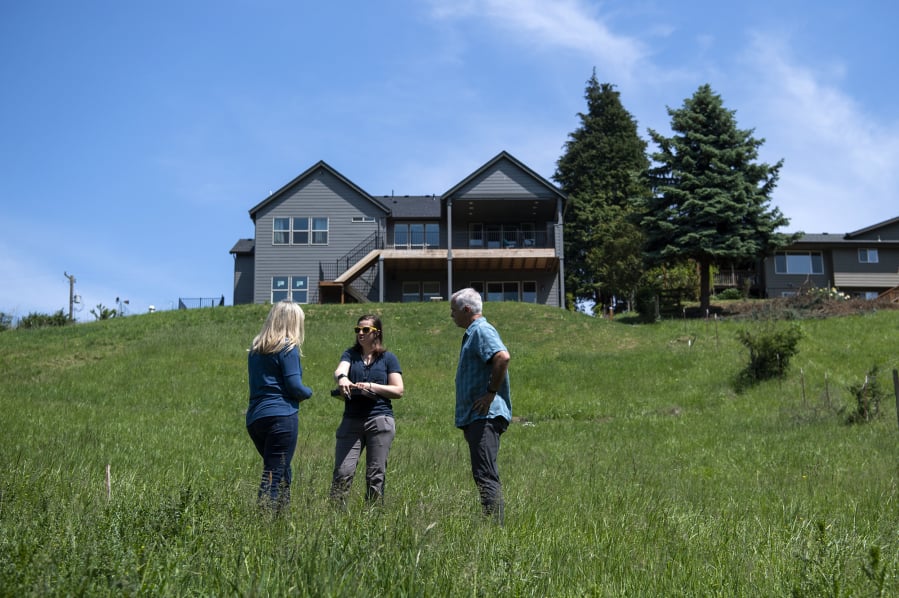RIDGEFIELD — Earlier this year, Julie and John Zanzi left Vancouver for a new house nestled in rolling pastures of old farmland in rapidly growing Ridgefield. Their new 1-acre home overlooks a field of grass left over from the previous farm that’s separated from Gee Creek by a blackberry patch.
Wanting to live in harmony with their new surroundings, they enrolled in a six-week class offered by the Clark Conservation District on watershed stewardship that included speakers on plants, fish, wildlife, and ground and surface water, as well as regulations.
“It inspired us to really do what we can to minimize our impact,” Julie Zanzi said.
That class included a follow-up visit to their home by Ashley Smithers, the district’s resource specialist, and Zorah Oppenheimer, its interim director. During the visit, they chatted about installing a rain garden, native shrubs, perennials and flowers to soak up polluted runoff before it washes into the creek. They talked about planting native flowers and red-flowering currants on the field of grass to prevent erosion and provide food for pollinators.
But just a few months ago, it wasn’t clear if the district could continue to offer free technical assistance like this to property owners. In September, the Clark County Council voted down a request from the district that would have charged most property owners $5 per parcel to keep the district financially afloat. The district said the new charge was needed to keep it viable after it saw a large source of grants from the state Department of Ecology dry up.
Although a county report described the district as a benefit to landowners, the council, worried about rising costs to taxpayers, voted down the request. In the wake of the council’s vote, there were questions as to whether the district could still function. But after several uncertain months, the district has begun rebuilding itself with some help from partner organizations.
“The district isn’t going on all cylinders,” said Stu Trefry, southwest regional manager for the Washington State Conservation Commission. “But what I think we’re seeing is there is a bunch of people that didn’t want to let it die, so we rallied around the district, and we are keeping it as relevant as we can.”
‘OK for the short term’
On the day the county council voted down the district’s funding request, Oppenheimer recalled returning to her office in Battle Ground. Waiting for her was a voicemail from a landowner asking for help. That landowner had been referred to the district by the county, Oppenheimer said.
At that time, the district had two full-time employees, Oppenheimer said. One employee followed through on a planned retirement in October, leaving Oppenheimer as the district’s sole employee to manage administrative duties and perform site visits.
“It was overwhelming, and it was lonely,” Oppenheimer said. “I’ll be honest, it was difficult, but I’m glad I did it because I love our staff.”
Trefry said the Washington State Conservation Commission, an agency that supports and oversees the state’s 45 conservation districts, noticed Clark Conservation District’s situation and stepped in to help with an additional $18,100 to keep it afloat.
He said the commission had funding to create a regional forestry stewardship position covering Clark, Cowlitz and Wahkiakum counties and decided to house the position in the Clark Conservation District. Trefry said the district has been able to use technical help from nearby districts, such as Skamania County’s Underwood District.
Dean Longrie, longtime chair of the Clark Conservation District’s board, said the district has also relied more on volunteers, and he’s come in to vacuum the office and clean the bathroom.
Oppenheimer moved her position to part time to save money and got a grant to hire Smithers as a part-time resources specialist in February. She said the district continues to rent out its manure spreader and poultry-processing machine. The state’s recently passed budget also had some good news: increasing funding for each of Washington’s conservation districts from $90,000 to $95,600.
“We are OK for the short term,” Oppenheimer said.
Budgets
Oppenheimer said the district’s budget is comprised of funding from the state, as well as a mix of overlapping local, state and federal grants. She said in an email that the district’s 2018 budget was $353,896, and its estimated 2019 budget is $531,000, which covers salaries and office expenses.
While the district’s budget increased, Oppenheimer explained that $285,000 passes through the district as it’s used to fund specific projects. The largest of these projects is an estimated $235,000 to fund a bridge construction project to help fish passage, she said.
She also said the district’s funding comes from 10 grants that have restrictions on how they can be spent. For instance, the district’s watershed stewardship grant covers the cost of classes and site visits for landowners in a dozen watersheds.
But Oppenheimer said that grants come with restrictions and can only be used to serve landowners in specific watersheds or those who have livestock near streams. She said the reason the district approached the county with its funding request was to be able to serve more landowners.
“We have so much to offer, and as we’ve stated repeatedly and strongly, just being grant-funded means you are restricted by geography or by topic,” Longrie said.
Room for growth
Trefry recalled how years ago he worked with a different district that had to essentially rebuild itself after a critical audit found significant managerial issues.
He said Clark County is in a similar position even though it doesn’t have the same managerial issues. Nearly 17 districts, including each one that has a population similar to the Clark Conservation District, has similar funding mechanisms to the one the Clark County Council voted down last year.
Longrie said the district has always operated with a lean staff, but there’s always been the potential for it to do more, especially as the county’s population grows. The district will be on the lookout for more sources of funding while improving what he said is already a strong relationship with the county.
In the meantime, he said, “We’re never going to get knocked out. I’ll tell you that.”




